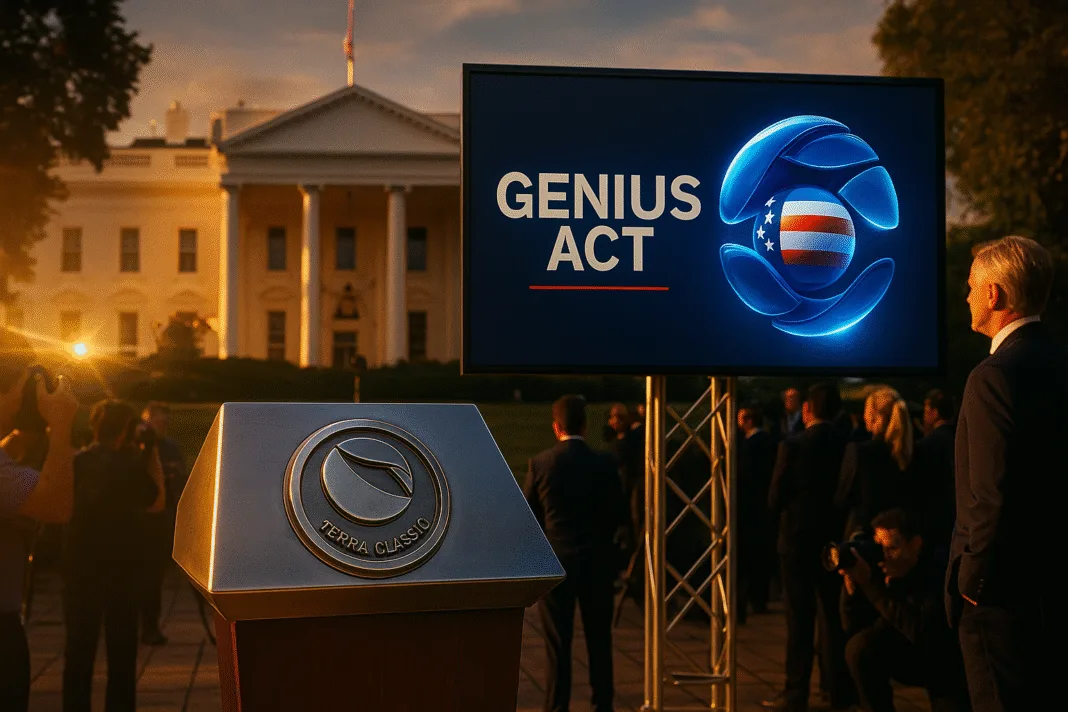A New Chapter for Crypto Regulation in the U.S.
In a landmark decision, the United States has officially passed the GENIUS Act, a new law requiring all payment stablecoins to be backed by U.S. dollars or short-term government securities. This development is part of a broader crypto reform effort, which includes other bills such as the CLARITY Act and measures limiting the use of Central Bank Digital Currencies (CBDCs).
Together, these laws are designed to provide long-awaited clarity for the digital asset industry, establishing legal definitions, creating oversight structures, and improving investor protection. Analysts are calling this a “regulatory leap” that could open the door for mainstream adoption of stablecoins and other blockchain-based financial products.
What This Means for USTC and LUNC
TerraClassicUSD (USTC) is a decentralized stablecoin that originally operated through an algorithmic model tied to LUNC (Terra Classic). Unlike traditional stablecoins backed 1:1 by fiat reserves, USTC maintained its peg through a burn and mint mechanism with LUNC—creating or destroying supply to keep its price stable.
This design failed in 2022, leading to the collapse of Terra’s original ecosystem. However, the community did not abandon the project. Instead, developers and contributors have continued to rebuild Terra Classic, focusing on restoring USTC’s value and improving its underlying model.
The GENIUS Act now brings a new opportunity. Although USTC is not currently backed by fiat or Treasuries, the law may allow for decentralized stablecoins to comply, if they can prove adequate reserves or implement improved mechanisms that meet transparency and safety standards.
Why USTC Could Still Become a Leading Stablecoin
Here’s why USTC, despite its history, could become a strong contender among future stablecoins:
1. Decentralization First
USTC is one of the few stablecoins not controlled by a private company. This aligns with the growing demand for financial systems that are open, community-driven, and censorship-resistant.
2. Community Resilience
The Terra Classic community remains one of the most active and organized in the crypto space. Proposals to re-collateralize USTC, reduce supply, and improve its algorithm have gained serious traction.
3. Regulatory Repositioning
The GENIUS Act doesn’t just shut out algorithmic models, it creates a path for them to evolve. If USTC integrates a hybrid reserve model with verifiable backing and improved controls, it could fit within the law’s requirements.
4. Strategic Link to LUNC
The value of USTC is deeply connected to LUNC. As LUNC strengthens through community development, utility use cases, and smart contract upgrades, it could provide stronger support for USTC’s stabilization mechanics.
5. Institutional Curiosity
Now that the regulatory environment is clearer, institutions may revisit algorithm-based models—especially those backed by large communities and open source governance. USTC could become a pioneer in this new category of compliant decentralized stablecoins.
Market Outlook and Strategic Focus
In the short term, USTC and LUNC are likely to see increased attention, especially as the U.S. Treasury and Federal Reserve begin to release technical guidance under the GENIUS Act. If the Terra Classic community can present a credible roadmap toward regulatory compliance—such as introducing partial fiat reserves or real-time auditing tools—USTC could re-enter the U.S. market as a legal, decentralized alternative to major stablecoins like USDC or USDT.
For LUNC, this also means renewed purpose. The token may evolve into the governance and economic layer for USTC, supporting smart contracts, collateral mechanisms, and decentralized treasury management.
Final Thoughts
The GENIUS Act is more than just a policy change—it marks the beginning of a new era in crypto finance. While many stablecoins will need to adjust or exit the market, USTC has a rare opportunity: to become a fully compliant, decentralized stablecoin built on the lessons of the past and the standards of the future.
With strong community backing, technical innovation, and a clear connection to Terra Classic’s long-term vision, USTC and LUNC could be at the center of the next generation of digital currency.

